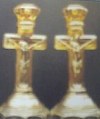Carnival Glass 101 | home Quick Reference to Carnival Glass Patterns on This Site
Jenkins and US Glass
JENKINS & U.S. GLASS
There are some examples in this segment which are very likely one-of-a-kind. Rather than repeat details of pattern, etc., we refer you to previously written accounts for verification. Many of the examples seen here came from collections of long-standing, and have not come into public view prior to their being sold at auction. Some of the U.S. Glass patterns discussed, can be seen in Book 5 - U.S. Glass From A to Z, by Wm. Heacock & Fred Bickenheuser.
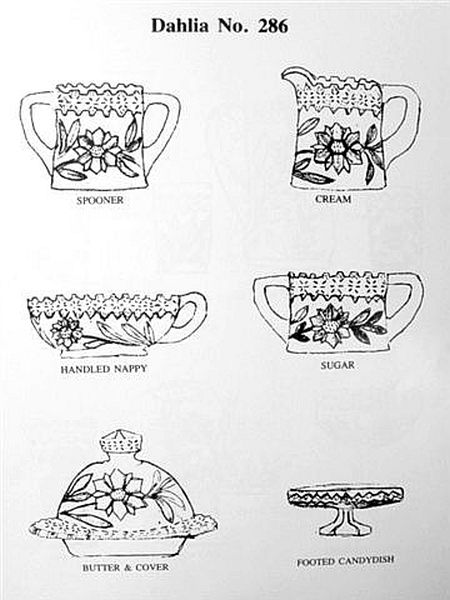
Dahlia No. 286 - Page 11, JUST JENKINS Book by Joyce Hicks,
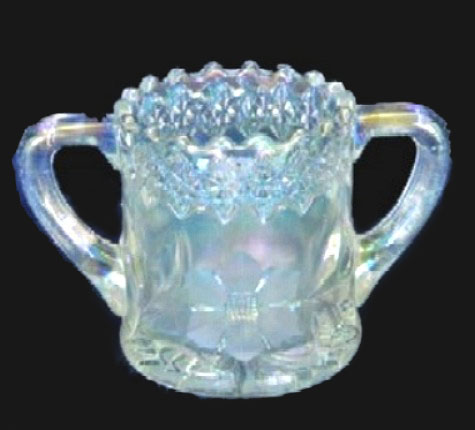
Diamond and Daisy Cut Spooner
DIAMOND & DAISY CUT (Spooner): Exception being the altered edge design seen on the Variant, the central design is the same! The Just Jenkins Book Displays 21 various shapes within this pattern. It obviously was a successful marketing element and one which would be subject to further marketing attempt by the U.S. Glass Co. following their purchase of the previous Jenkins moulds!
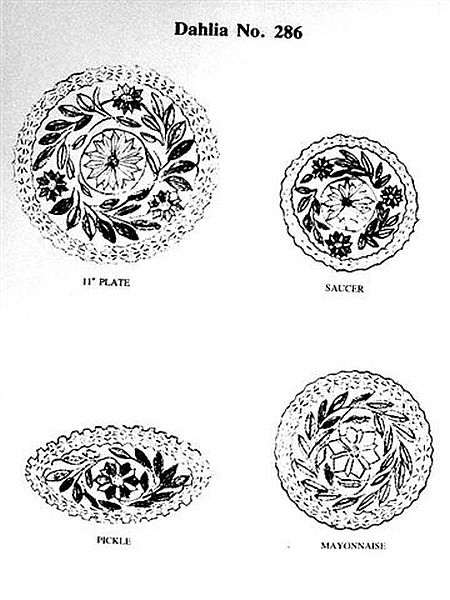
Page 14, JUST JENKINS Book ny Joyce Hicks.
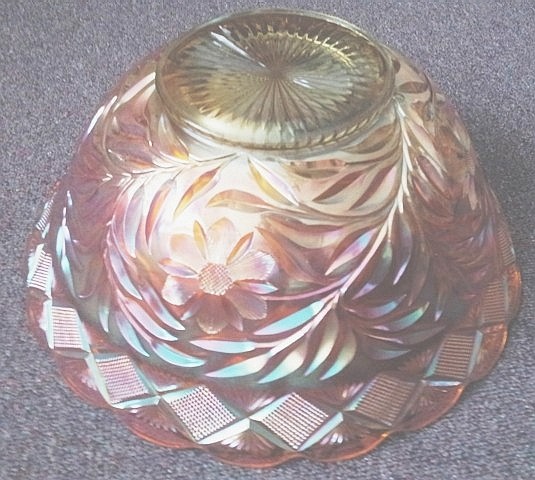
DIAMOND and DAISY CUT VT. - 6.5 inch marie.
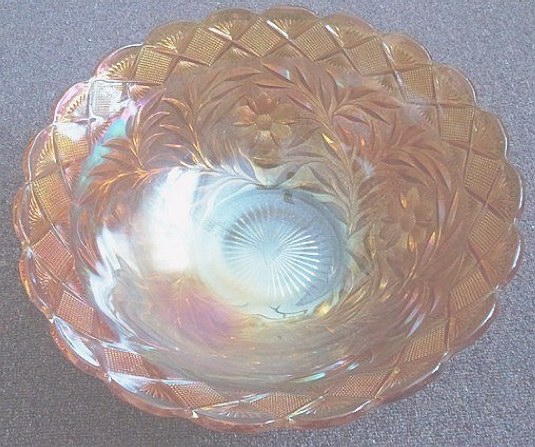
DIAMOND and DAISY CUT VT. Punch Bowl - 16.75 in. span!
DIAMOND & DAISY CUT VT. Bowl: Seemingly, this is a variation of the earlier Jenkins DAHLIA design found on 21 various shapes accredited to that company. When the first Jenkins factory, built in 1886, was sold to United States Glass Co. the moulds for the original pattern may have been sold, as well. Re-working an original mould, placing the new edge design seen on this bowl “may” have occurred?
Another possibility: We know that D.C. Jenkins erected a plant in Greentown, IN, in 1893. In 1899, that plant was purchased by National Glass Co. Pittsburg and for a couple of years Mr. Jenkins was chairman of the executive committee and general manager of the company.
In 1901, Mr. Jenkins and his sons, organized The Kokomo Glass Mfg. Co. (in Kokomo, IN). This plant was destroyed by fire in 1905, rebuilt in 1906 and resumed operations as the D. C. Jenkins Glass Co.
In 1914, Mr. Jenkins started another glass factory in Arcadia, IN. Both plants were in operation until 1932.
Possibilities are numerous! We know that the Dahlia pattern had been a successful seller. “Perhaps” over the ensuing years, Mr. Jenkins used the basic pattern, adding the edge seen on this unusual bowl, and possibly a “missing large under-plate” for it to sit on, lending use as such during the Depression years? (Surely this large bowl could not sit atop a punch bowl stand!) Photos are provided by Christina Katsikas.
Considering the fact that the bowl is 16 ¾” wide across the opening, is 6 ¼” to 6 3/8” tall (to its highest scalloped point) and offers a 6 ½” marie, we might conclude that it was designed to sit atop a plate (which in essence could be shaped from the flattened bowl mould), with the result being a desirable serving combination to impress the users during the Depression years? The question is: WHO will discover the under-plate?
Click into Imperial’s Confusing Patterns to view a typical bowl - under - plate.
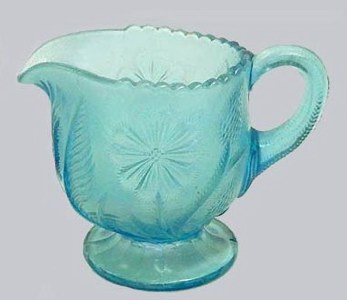
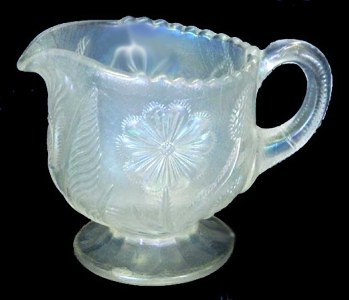
Celeste and White Field Thistle Creamers
FIELD THISTLE Creamer: Said to be the only one known in Celeste blue, Seeck Auctions sold it in April 2013 during the HOACGA Convention. We believe it to be the same creamer referred to in an article which appeared in a U.S. GLASS book written by Wm. Heacock in 1985. He called it pastel blue. You may read that account by clicking into - U.S. Glass – Part 3.
White U.S. Glass is a “given”! Cosmos & Cane, as well as Palm Beach examples are well-known in white.
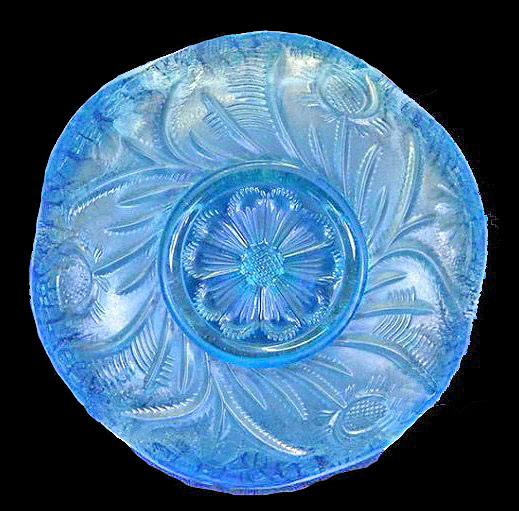
Celeste FIELD THISTLE 5.5 in. Sauce-Courtesy Seeck Auctions.
FIELD THISTLE Sauce: Although this Celeste blue color is seen on a few other shapes within the pattern, this sauce may well be the only example in this shape?
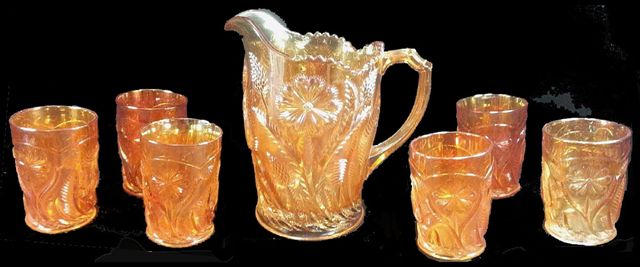
Field Thistle Water set in Marigold.
FIELD THISTLE Water Set: Although Honey Amber is a familiar color in connection with U.S. Glass patterns, this particular water set has the attributes of marigold coloration. Someone has taken extremely good care over many years, in order for this matched set to be complete in today’s world! Of c. 1910 production, the pitcher is 8 ¾” tall. Tumblers are 4 ¼” tall.
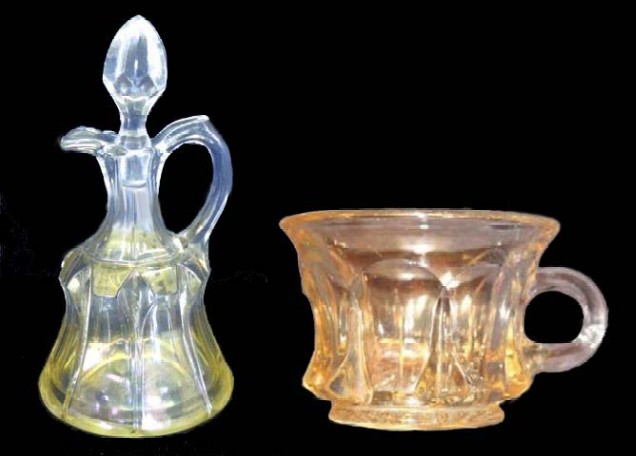
PORTLAND Cruet and Punch Cup.(Courtesy J & C Curtis).
PORTLAND Punch Cup: Jerry and Carol Curtis found this cup early in 2013. It leads to thoughts of a punch bowl and more cups! Should any of our viewers have information of an existing punch bowl, we would appreciate hearing from you. Other items within this Portland pattern may be seen in our U.S. Glass – Part 15.
PORTLAND Cruet: This item was sold by Seeck Auctions in April 2003. It had been in a longtime collection. It offers the same pale coloration found on other items in this pattern, leading to the belief that it was an after-market application, similar to the Texas Mineral Bath the Curtis’ informed us of earlier! See Mineral Bath Marigold segment.
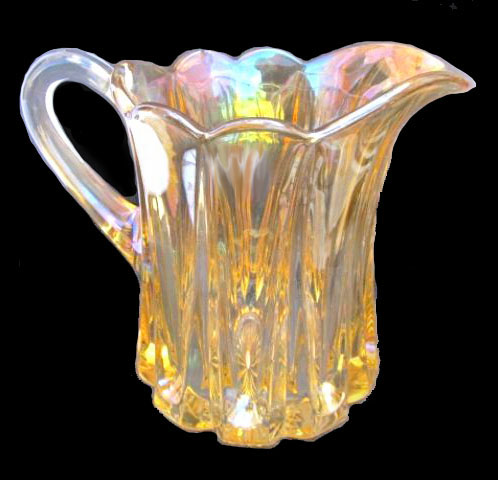
PORTLAND or LONG BUTTRESS Pitcher.
PORTLAND Water Pitcher: Included in the June 2013 ACGA Convention Auction conducted by Wroda Auctions, this pitcher sold for $215. The toothpick in this pattern sold for $125. during the same auction. This pattern is sometimes called Long Buttress.
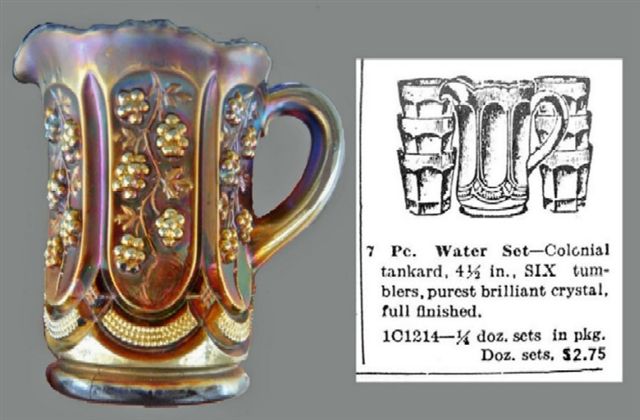
U.S. Glass VIRGINIA BLACKBERRY Child's Pitcher - Cobalt Blue
and Butler Bros. Ads (Appeared both Feb. 1919 and Aug. 1920).
VIRGINIA BLACKBERRY Pitcher: While this 4” pitcher having a base diameter of 2 ¼” was pictured in articles written by the late John Britt, as early as the 1980s, with acclimation given to U.S. Glass as the manufacturer; we do not know which of the factory conglomerates might have claimed the mould? No doubt some of the factories within that group utilized in-house ability to create and in this case, rework a former mould; adding the blackberries.
During the 1920s-30s, products were sold by traveling salesmen; (my Dad (Diane’s) traveled/sold for a hardware company up until WWII). “Samples” were a large part of the wares he displayed to potential buyers, but not every sample provided orders! In the case of this pitcher; perhaps fewer than a half dozen samples were distributed to various salesmen around the Country? It is quite possible no orders were received!
There was a time in history when creamers with extra milk for adding to a bowl of oatmeal, etc. were placed on breakfast tables. (My Grandmother did so.) As with everything else (which went before), that era ended. With it, the need for a lone creamer passed into history!
The example which sold in 1994 for $625. was cracked and had belonged to John Britt. The pitcher which was advertised on eBay in March 2013 was purchased by Tom Mordini. The seller noted that the pitcher has some 50 “nicks”, so it obviously has been “over the road” for quite sometime! None-the-less, this could well be the only remaining known example in the pattern? Color is cobalt blue. We do not know whether this is the same pitcher which sold in 1994.
You will notice the Butler Brothers Ad names the pattern “Colonial”. It first appeared in the Feb. 1919 Catalog, and again in Aug. 1920, so it was sometime after that when the original mould was re-worked to add the berries. In both ads, the set was in company with several other “children’s items”.
Dean & Diane Fry, Sept., 2013

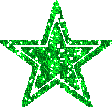





“Let not your heart be troubled; you believe in God, believe also in Me.
In My Father’s house are many mansions; if it were not so, I would have told you.
I go to prepare a place for you. And if I go and prepare a place for you,
I will come again and receive you to Myself;
That where I am, there you may be also. And where I go you know, and the way you know.”
Thomas said to Him, “Lord, we do not know where You are going, and how can we know the way?”
Jesus said to him, “I am the way, the truth, and the life. No one comes to the Father except through Me.”
(John 14:1-6)







Should you care to contact the Frys, their email address is:
Search Carnival Glass 101
back to Carnival Glass 101
Our other sites you may enjoy:
Everything you EVER wanted to know about Indiana Glass
Great Reference for Newer Carnival Glass.
Complete Glassware Catalogs Available to Download
Questions? Comments? Suggestions? Broken Links? Corrections?
Your Friendly Webmaster is here to help!
